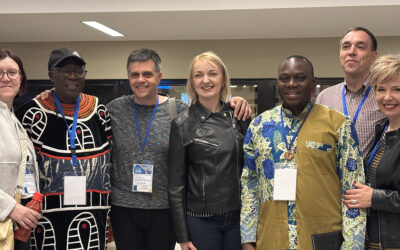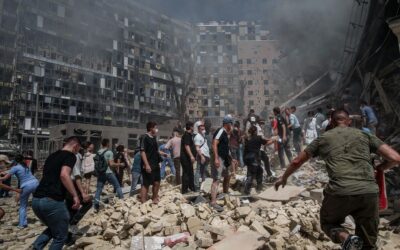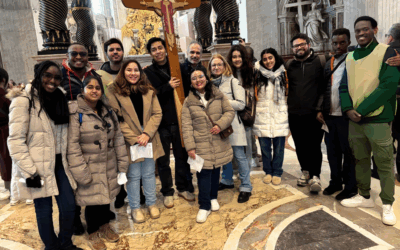Once the spark of brotherhood is ignited it creates a positive chain reaction, spreading with exponential force in the relationships among classmates and colleagues until it becomes a way of life. It creates a different kind of environment: Everyone was involved and felt responsible for becoming the change they want to see, as Gandhi had once said.
 This was the experience of some students and teachers at a secondary grammar school in Sarcelles, a well known Paris suburb. One day at school two foreign girls were engaged in a very violent argument. It was 28 September 2007. What to do? Lower your head and walk away? Pierre Benoit, the Italian teacher, decided to intervene. He proposed a new method, the method of brotherhood. He explained to his students: Each morning you throw a die, the brotherhood cube. Each of its six sides has a different phrase. For example: “Consider every man as a brother, and every woman a sister,” “See the other in a positive way,” “Take the first step toward the other,” “Reach out to your enemy,” “Understand the other” and “The other also sees me as a brother or sister.” Each day that you throw the die, you have a new proposal that you can put in practice. Then at the end of the week, you share how it went.
This was the experience of some students and teachers at a secondary grammar school in Sarcelles, a well known Paris suburb. One day at school two foreign girls were engaged in a very violent argument. It was 28 September 2007. What to do? Lower your head and walk away? Pierre Benoit, the Italian teacher, decided to intervene. He proposed a new method, the method of brotherhood. He explained to his students: Each morning you throw a die, the brotherhood cube. Each of its six sides has a different phrase. For example: “Consider every man as a brother, and every woman a sister,” “See the other in a positive way,” “Take the first step toward the other,” “Reach out to your enemy,” “Understand the other” and “The other also sees me as a brother or sister.” Each day that you throw the die, you have a new proposal that you can put in practice. Then at the end of the week, you share how it went.
 The teacher’s proposal was inspired by the “Cube of Love”, a game which Chiara Lubich invented for children in order to make gestures of brotherhood more fun. The cube was introduced into this Paris school in a more universal form, in a language that was less religious and within the grasp of anyone. The teens accepted the challenge and really took the lead. There were thrilling results: The school became the scene of a different world, where for the first time stories of reconciliation and friendship were becoming intertwined. One girl comments: “It’s ridiculous to destroy one another just because of a word or a look or a phrase that someone keeps on repeating!”
The teacher’s proposal was inspired by the “Cube of Love”, a game which Chiara Lubich invented for children in order to make gestures of brotherhood more fun. The cube was introduced into this Paris school in a more universal form, in a language that was less religious and within the grasp of anyone. The teens accepted the challenge and really took the lead. There were thrilling results: The school became the scene of a different world, where for the first time stories of reconciliation and friendship were becoming intertwined. One girl comments: “It’s ridiculous to destroy one another just because of a word or a look or a phrase that someone keeps on repeating!”
 Soon these experiences were featured in short films that were made by the students themselves. They tell the stories of how a reconciling word was able to destroy a cycle of enmity and violence. That same year, in 2007, a festival was planned. It was entitled “Brotherhood in the School, Brotherhood in the City”. More than 250 people participated, including three Mayors.
Soon these experiences were featured in short films that were made by the students themselves. They tell the stories of how a reconciling word was able to destroy a cycle of enmity and violence. That same year, in 2007, a festival was planned. It was entitled “Brotherhood in the School, Brotherhood in the City”. More than 250 people participated, including three Mayors.
 A year later an association was founded called “Fratern’Aide” (Fraternity Aid). Its goal is to help build peace, brotherhood and solidarity among people. Many projects had been promoted during these years. Then the youths of Sarcelles won First Prize in the National Competition sponsored by the Human Rights League: “Writings on Fraternity.” The teenagers went out to present their method in other schools of the Paris area and in October 2010 the association was invited by the Network of Citizen Schools (RECIT) to schools in other regions. The experience also captured the attention of the philosopher Bruno Mattei, professor at the University of Lille and author of the book “Is Brotherhood Possible?” The method even reached the attention of UNESCO (which in 1996 had awarded Chiara Lubich with the Education for Peace Award), where it was presented to an audience of UN Ambassadors. Once true brotherhood is put in motion, nothing can stop it!
A year later an association was founded called “Fratern’Aide” (Fraternity Aid). Its goal is to help build peace, brotherhood and solidarity among people. Many projects had been promoted during these years. Then the youths of Sarcelles won First Prize in the National Competition sponsored by the Human Rights League: “Writings on Fraternity.” The teenagers went out to present their method in other schools of the Paris area and in October 2010 the association was invited by the Network of Citizen Schools (RECIT) to schools in other regions. The experience also captured the attention of the philosopher Bruno Mattei, professor at the University of Lille and author of the book “Is Brotherhood Possible?” The method even reached the attention of UNESCO (which in 1996 had awarded Chiara Lubich with the Education for Peace Award), where it was presented to an audience of UN Ambassadors. Once true brotherhood is put in motion, nothing can stop it!




0 Comments